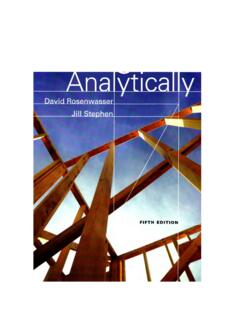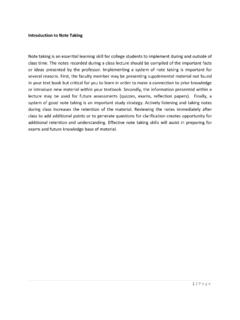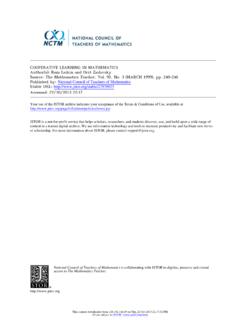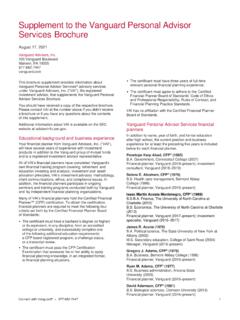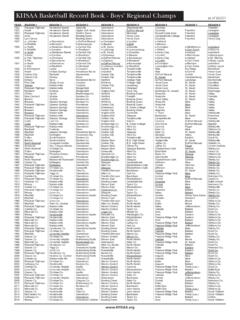Transcription of Writing Empirical Papers Beginners Guide - Muhlenberg …
1 Running Head: Writing Empirical Papers 1 Writing Empirical Papers : Instructions for Beginners Connie Wolfe Muhlenberg college Note: This Guide is intended for students new to Writing Empirical Papers . It is based on conventions used in social psychology; different sub-disciplines have additional or different requirements. The emphasis of the Guide is on Writing process and content. This Guide assumes students have or will invest time outside the Guide learning things like how to report statistical results, proper formatting for tables or figures, line-spacing and headings, and APA citation style. Free for re-use with minor modification, but please include an attribution to Connie Wolfe and Muhlenberg college . See mistakes or want to recommend changes? Email Writing Empirical Papers 2 Writing Empirical Papers : Instructions for Beginners In his frequently cited chapter, Daryl Bem suggests that crafting a well-written Empirical paper is like "telling a story.
2 " There is exposition at the beginning (the Introduction), rising action (the Method), a climax (the Results), and denouement (the Discussion). Many students believe an Empirical paper requires a unique Writing style that is new and foreign to their typical Writing style. This is usually a mistake. Like any piece of analytic Writing , your primary objective is to communicate a coherent and well-organized argument to the reader. Make good use of the Writing and critical thinking skills you already have. Although your language will be formal and you must attend to the proper content required by APA-style, your paper will turn out better if you keep this notion of story-telling in mind as you write. As you write, never forget you are communicating with a person. Overall Shape of Paper A well-written Empirical paper should be shaped like an hourglass. That is, the Introduction begins very broadly by introducing the topic and defining terms, and then begins to narrow to more specifically focus on the variables in your study.
3 At the end of the Introduction, the paper is at its most specific (or "narrow") in that the Method and Results both provide extremely focused information about your study. The Discussion begins by reviewing your specific findings, but then starts to slowly broaden out again as the implications are discussed. By the end of the Discussion, the paper has become as broad in focus as it was at the beginning of the Introduction. Thus, an hourglass shape. Below is information about the content within the hourglass. Introduction The purpose of the Introduction is to explain your research question. In doing so, you will emphasize the importance of the question and present a possible answer to the question (the hypothesis). The very first paragraph of the paper is important and difficult to write. It is often easiest to write this paragraph after you have finished Writing the rest of the paper.
4 This first paragraph should capture the reader's interest and orient the reader to your topic, giving a sense of the concepts the paper will cover. However, you should not present your hypothesis or summarize your entire argument in this first paragraph. This is a stylistic paragraph more so than one that engages in analysis. so will probably just confuse the reader. It is mostly a stylistic paragraph to orient the reader to the general topic and your question. For more on this, see the section on "Opening Statements" in the Bem Chapter. You probably know you will be presenting past research in the Introduction. You may not, however, have considered the underlying goals of this review of the literature. Your central goal is for the reader to understand the need for more research in the area ( , your proposed study), and to be able to clearly see the reasoning for your hypothesis.
5 Thus, after you have gathered the theories, concepts, and Empirical findings you want to include, be intentional about your organizational strategy. A common rookie mistake is to write a brief paragraph for each theory or study, without any organizational structure at all. A common way of fixing that mistake is to add transition sentences between paragraphs. Unfortunately, that overall approach usually makes for a poorly written paper. Instead, try using this as a guiding question: "what does the reader need to know now so they will understand what I'm going to tell them later?" Put the elements of your paper into a sequence that, at each step, gives the best answer to that question. You already know that the very last thing you will tell the reader in this section is your hypothesis. Everything prior to the hypothesis should be organized in a way that logically builds to your study.
6 You are not just describing past research, you are crafting a line of reasoning which leads to your research question. By the time you present your hypothesis, the reader should be able to guess what it will be based on the way you have reviewed and analyzed past literature. Thus, your first step should be to develop an organizational strategy. Writing separate paragraphs for each theory or study before considering the organizational strategy makes it very difficult to adhere to the best, most logical ordering of the information. What follows is an example of one organizational strategy. It is not right for every paper, but it is a good example if you are uncertain how to begin. Writing Empirical Papers 3 INTRODUCE YOUR TOPIC, REVIEW BACKGROUND LITERATURE After your opening statement, choose one of the concepts ( , variables) that is relevant to your study. If you wish, you can label this section of the paper with the name of that concept.
7 To begin, explain the concept. Your explanation should define the concept and explain "how it works." Explaining how it works might mean presenting a theory and/or it might mean explaining important relationships the concept has with other variables. Discussing theory and Empirical findings helps illustrate and provide evidence for your explanation of the concept. As you choose how much detail to include in the paper, remember that your goal is to provide the reader with information about the variable that will help them understand your study. So, try to choose evidence and details that will specifically meet that goal. Note: this entire section is about the one concept. You do not need to incorporate your other variables, or even mention your hypothesis yet. Provide a transition Review the next relevant concept from your hypothesis. If you used a section heading for the previous variable, provide a new heading for this one.
8 Again, explain the concept, providing information about what is known about the variable/theory/concept (using Empirical study descriptions where appropriate). Continue this process until you have defined all relevant concepts and reviewed most of the relevant background literature. BRINGING IT ALL TOGETHER: PRESENTING YOUR RESEARCH QUESTION AND LOGIC FOR HYPOTHESIS Many Papers use the heading "The Present Study" for this section of the paper. Now that the reader knows the relevant definitions and background, you can bring together the research evidence reviewed above to present your research question. Begin by explaining what is unique/original about your research; that is, explain the "gap" in past research that your study seeks to fill. There are different kinds of gaps including: a. a contradiction among past findings; b. a reason why the conclusions reflected in the reviewed literature might be wrong; c.
9 A more literal gap something you consider important that has not been studied; d. a point that, although it is dealt with in the readings, ought to be extended further in some other way. In describing this gap, writers often find that there is at least one "key" study that is especially important. Perhaps it is the study that most clearly illustrates the gap, or comes closest to addressing the gap. Perhaps the "key" study is one you plan to replicate and extend. Sometimes the best organizational strategy is to present that study in detail here (rather than in the previous section of the Introduction). In deciding how much and which details to include, remember your guiding question: "What does the reader need to know to understand the importance of and logic for my hypothesis?" This "gap" in the literature is your research question. You should provide a possible answer to the question; this is known as your hypothesis.
10 As you know, a hypothesis is a prediction. A rookie mistake is to provide the hypothesis with no explanation. Step-by-step, explain why you are making the prediction you are. In the last paragraph of your Introduction, name the specific variables you intend to study and generally what you will be asking your participants to do ( ..we plan to administer a survey measuring both variables X and Y to determine if there is a correlation. ). Finally, re-state your hypothesis(-es) formally, referring to the specific variable names and using relevant statistical language ( , "We hypothesize that X will have a positive correlation with Y." or We hypothesize that participants in the experimental condition will score higher on Y than participants in the control condition.") Writing Empirical Papers 4 Method Note, the title of this section is Method not Methods (no s).

